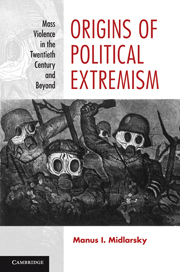Book contents
- Frontmatter
- Contents
- List of figures and tables
- Preface
- Introduction
- PART I Theory and Empirics
- PART II The Secular “Isms”
- PART III An Ostensibly Sacred “Ism”
- 6 Radical Islamism: Foundations
- 7 Contemporary Radical Islamist Movements
- 8 Muslims in India
- PART IV Extreme Nationalism
- PART V Conclusion
- References
- Index
7 - Contemporary Radical Islamist Movements
Published online by Cambridge University Press: 05 June 2012
- Frontmatter
- Contents
- List of figures and tables
- Preface
- Introduction
- PART I Theory and Empirics
- PART II The Secular “Isms”
- PART III An Ostensibly Sacred “Ism”
- 6 Radical Islamism: Foundations
- 7 Contemporary Radical Islamist Movements
- 8 Muslims in India
- PART IV Extreme Nationalism
- PART V Conclusion
- References
- Index
Summary
In the post-World War II period, we have seen the rise of radical Islamists that have committed mass violence. Al-Qaeda, al-Muhajiroun (in Britain), the Sudanese government, and the Shamil-led Chechen Islamists are cases in point that will be reviewed in this chapter. The last of these groups committed the Beslan school massacre that was mind-numbing in its murder of 186 children, among others. This and the centrality of Chechnya in the radical Islamists' worldview have led this case to receive more attention in this chapter than others.
Al-Qaeda
The regimentation of politics also characterizes the origins of late twentieth-century radical Islamism. Abdullah Azzam is generally recognized as the first of the prominent jihadists who ventured into Afghanistan immediately after the Soviet invasion of 1979. Earlier, as a Palestinian born in Jenin, he fought in the Six-Day War of 1967 and in the Palestinian resistance. But Arab oppositional movements like the Palestine Liberation Organization (PLO) were insufficiently religious for him. He joined the Muslim Brotherhood and later was among the founders of Hamas, before obtaining higher degrees in institutions of Islamic learning. According to Terry McDermott, in Peshawar, the emerging capital of the Afghan resistance headquartered in Pakistan's Northwest Frontier, “Azzam found his cause: Afghanistan would be the incubator for a new, muscular Islam, a religion of warriors like that of the Prophet's time.” Violent revolt against the “apostate” Muslim regimes was required; as Assam said, “Jihad and the rifle alone: no negotiations, no conferences, and no dialogues.”
- Type
- Chapter
- Information
- Origins of Political ExtremismMass Violence in the Twentieth Century and Beyond, pp. 161 - 185Publisher: Cambridge University PressPrint publication year: 2011



